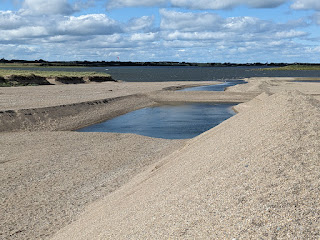I have a Free Travel pass. There is no additional charge for a bicycle on Iarnród Éireann, but it is necessary to book a bicycle as space is limited. So I booked this trip a few days in advance choosing two days that Met Éireann assured me would be fine. But this is Ireland: on my departure day the forecast had changed to rain most of the second day.
My route was inspired by discovering the An Coinigéar or the Cunnigar, a sand spit which, we are told, has formed as a result of deposition by longshore drift, the movement of sand along the coast by the waves and the estuary emerging at the north of the bay slowing it down. As time progressed, the deposited material has formed a spit, which is 2.6 km long and which almost closes Dungarvan harbour at its northern end.
Check out these drone shots which suggest that there is much more to Cunnigar under the surface that appears to the naked eye. A bit like an ice berg.
Waking ahead of my 05:00 alarm I breakfasted hastily and mounted my trusty steed for the 2+ hour ride to Heuston, Dublin where I caught the 08:00 service for Cork. Alighting at Limerick Junction I took the so called "inter city" to Waterford which pootles through the beautiful Suir valley at a leisurely 60 to 80km/hr. Arriving at last I cycled the 46km of Waterford Greenway to Dungarvan.
 |
| Whistlestop Café, Kilmeadan Station |
My plan was to luncheon at the Whistlestop Café but in the event their most excellent tea and scone (served warmed with butter and: would you like strawberry, raspberry or blackcurrant jam?) did the trick.
Arriving in Dungarvan ahead of schedule, my first port of call was Lidl where I purchased hardtack and orange juice (not wishing for Scurvy), then hung around until the F&C shop opened. Suitably fuelled I then set off for the Cunnigar.
On turning off the N25 a sign announces you are entering the Gaeltacht after which all road signs are in Gaelic only. In English An Coinigéar means "rabbit warren". This rabbit warren business: last year's Forays to Coney Island and Omey Island were also nominally overrun with rabbits. On this occasion I saw none but, instead, there were cattle freely roaming the whole peninsula - more of that later.
Here is a beautiful video of the Cunnigar by @fardinger:
And here are a few of my photos, or click here to view the album.
 |
| Dungarvan town from the tip of the Cunnigar |
 |
| The beach on the sea side is so shallow |
 |
| Avonmore bridge Cappoquin, stock photo |
The bridge has some history. It was a Potato Famine relief project of the Keane family and was opened in 1851 but the original name, ‘Victoria Bridge’ was later chiselled out by nationalists. The bridge was a target of attack during the Troubles of the 1920s. There is a place where an explosion required extensive repairs to be done. For all that, it was my planned route, rather than follow the probably easier going but boring N72. But all places tend towards boring in the rain.
 |
| Proof of arrival at Mallow train station. |
Oh - and regarding having to book a bicycle space - on the Mallow Portlaoise segment all three bicycle hooks were in use, plus a couple more bikes randomly distributed, and that before I added mine! So somebody wasn't booking, and nobody seemed to care.
















